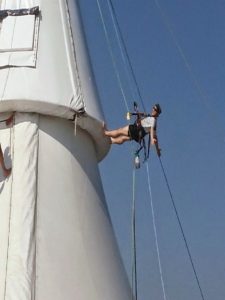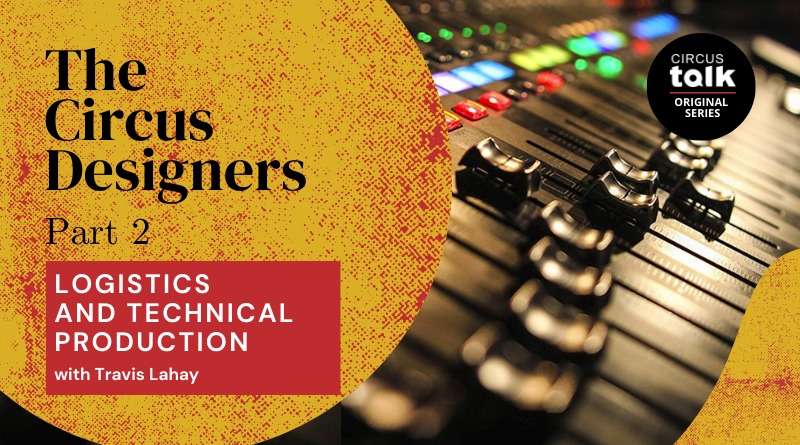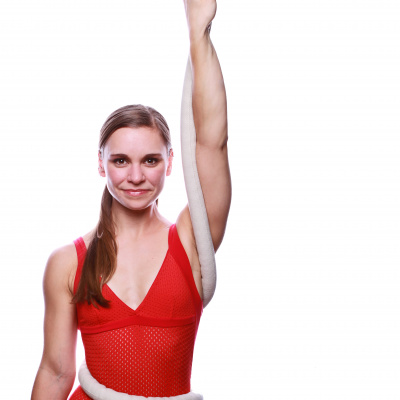Logistics and Technical Production Savvy with Travis Lahay
I’m going to start at the end. When wrapping up an interview, I like to ask if there’s anything my interviewee would like the CircusTalk readership to know. It’s a chance to open the floor to their expertise and for them to speak directly to you, our circus community. Without hesitation, Travis Lahay replied, “Everything is possible. And if you want it enough, you can go out and get it.” With that, all the puzzle pieces of our conversation fell into place. Lahay has fully embodied this advice in his career, and he is an example of how consistent determination can “create the life you want to live.” His resume reveals a steady climb up a twisting ladder — rungs marking a variety of positions in the circus sector — which has landed him as Head of Carpentry and Props on a large, internationally touring show.* His expertise and advice is a phenomenal addition to The Designer Series as Lahay offers a window into the practical and social skills necessary to work in circus Logistics and Technical Production departments.
It’s a familiar phrase, “a circus came to town,” but it’s how Travis Lahay’s unique circus journey began. He graduated from York University as a playwright and theater technician. When a big top rolled in, he was working for a local company that was hired to clean the tent. “It’s like being on a giant bouncy castle all day,” and he thought with exuberance, “I can get paid to do this?” Knowing he wanted to travel, he had been applying for touring shows and gigs, but quickly encountered a Catch-22. You need experience to get hired, but you can’t get experience unless you get hired. His in: a friend who was employed to set up the bleachers for a touring circus production. “It’s always the people you know. Your networking connections are the most paramount thing. You could be totally qualified and have all the skills, but still not get the job… The only way to get my foot in the door for circus was to go in through these logistic roles.” Bleachers is the “crew that nobody wants to do,” but it was Lahay’s entry point to circus life. Having proved his worth as an employee, he started to get hired for fly-ins. (Quite literally, you fly in to where a show is playing next, set up the production, and then fly back for tear down when the run has ended.) It was a classic freelancer lifestyle. He bounced between three different shows in North America with a pattered schedule of a few weeks on, a few weeks off. Time at home was like vacation. Lahay enjoyed the work, enjoyed the travel, and was able to maintain a steady home base with his partner.
It’s always the people you know. Your networking connections are the most paramount thing. You could be totally qualified and have all the skills, but still not get the job.
One goal of this series is to unveil the scope of circus design and production positions. Many people, even others involved on the same show, don’t know just how involved the work of a particular department might be. (I posed the same question in my last interview to costume designer Jenny Leigh Du Puis revealing a massive list of people that might be responsible for a single costume.) I asked Lahay the array of tasks that “logistics” encompasses for a circus production. His reply: everything from pitching the tent, washing it, setting up the bleachers, front of house, any maintenance needed on the site. If necessary, building a floor for the show, fencing for the lot, electrics, plumbing, HVAC systems for heat. Lahay even told me a story about replacing wooden flatbeds and the doors on production trucks. To accomplish any of these tasks, simple, direct problem solving is key:”What are the doors made of? Figure it out. Do the work.” The words fixing, installing, building were repeated throughout his explanation. “Part of my journey was having been in school for technical theater, not knowing much about logistics at all, and then experiencing it on the job,” and “experience” in this case means everything from the practical know-how to execute the actual work, the physical ability to complete the task, knowing how to care for the toll it takes on one’s body (such as spending 8 hours in a harness), how to stay safe working on a team, and the social skills needed for clear communication within the cultural etiquette of the position.

I asked Lahay how someone gets started in circus logistics. “You take any job you get offered. Learn it. Become good at it. Show you care, show you can do it well, and then someone will notice. You have to get in where you can. I’m happier that I did the logistics run around for so many years because the knowledge I got from that is so valuable to my job now. I know exactly what the other half of the crew is doing. I can sympathize… It helps you appreciate [other people in other positions].” Practical skills you could acquire to ease your entry into a logistics position could be: learning how to drive a forklift, taking a rigging course, or gettin certifications through IRATA, the International Industrial Rope Access Trade Association. I asked if having these skills would break the Catch-22 of needing experience to get hired but not having experience until you get hired. Lahay noted that circus is specific, and there are certain things that you simply have to learn on the job and from other experienced circus professionals. Again, Lahay advised that building relationships and interpersonal communication are key. “It’s a small industry — it’s global, but the world is small. Ask the questions: how did you start working? Is there a way I could do that?”
Lahay always answered my questions in clear, direct statements — evidence of the necessary communication style for his work. In writing, it may read as curt or cold, but Lahay has a radiant, warm personality. Our conversation was easy and filled with laughter. He’s funny, and shared that he often compares the communal effort needed to make a production a success to a Star Trek journey. “We’re all on the Enterprise, and we’re all flying this ship across the world.” Agreeing wholeheartedly, I dove into my next topic: communication.
Never say no to a director or designer. That’s the golden rule.
I asked what best practices for communication he needed in his current role as Head of Carpentry and Props. Lahay described an ideal setting, “Everyone talks nicely to each other. There’s no need to yell. Pass on information as clear and concisely as you can without rambling on. And make the magic happen!” We spoke about the ingrained cultural etiquette of specific professional settings — things you absorb from a work environment. He described two scenarios that, as a teacher and mentor to young performers, I concurred are key to success in the performing arts business. First, as a young employee, others will offer advice how a task could be accomplished (not to be confused with a directive from a manager or higher-up). “You’ll always have the older person come up to you — when you’re fresh and green. Someone will always want to tell you how to do something their way. You just listen, because whether you end up doing it that way or not, the job just has to get done.” It’s a lesson in patience, listening, respect for people with more experience, and camaraderie. It’s a learned social skill. “Interpersonal skills is a key to survival in this business.”

I asked Lahay how one might cultivate that skill in order to succeed in the performing arts business. His second scenario answered this question. “Never say no to a director or designer. That’s the golden rule.” An example: “A creative idea is floated in a meeting. As a department head, you think, that will never work! You’re the expert, and you can foresee the complications. Just say, ok, let’s try it, and let people come to a realization on their own. The point has been made without you looking like a jerk. It might sound fake, but you’re never going to convince a person by coming straight at them. You need to lead them through that same mental journey that you just did in five seconds.” I spotted this as a teaching technique: educing information from someone through problem solving is always more effective than giving them a rote answer based on your own experience or expertise. “Now we’re getting into philosophy of the social contract. You need to teach people how you want to be treated,” Lahay replied. And despite one’s expertise and foreseeing practical hurdles or budgetary restrictions, he said that saying yes to an idea can lead to being “genuinely surprised! Because people think around the problem, and a new idea emerges. You say yes, and then you say, let’s try it — but you’re going to need this much money and this much gear. You can do almost anything if you have enough budget, and you can find a way.”
What I learned from Lahay is that the numerous departments and tasks housed under Logistics and Technical Production, especially in circus, are intricate jobs that require impeccable communication, analytical thinking, and enormous practical, hands-on skill. At times, tasks can be physically grueling, but Lahay has been able to counter potential drudgery with a positive mindset. “There’s this mentality that work — especially around certain jobs — is not something you’re supposed to enjoy because it’s work. Maybe that mentality existed around [installing] the bleachers. Like Sysaphis, we beat the gods by saying, who cares if it’s a crummy job?! We’re going to do it every day, and we’re going to be happy about doing it every day. And if we somehow find joy in, it’s not a punishment. I don’t want to be at a job that’s not fun. That way it doesn’t feel like work.” Good advice for sustaining the physically taxing facets of working for and with the circus. More generally, Lahay advocated for the kind of steady determination that has brought him success in his own career path. “If you wake up and you have the gusto for it,you set a goal, and every breath is directed toward getting that accomplished.” Lahay’s infectiously rosy outlook and initiative rubbed off on me; I left our conversation inspire to strengthen my circus network, learn from those around me, and infuse my daily tasks with gusto for my circus goals.
*Because this was a personal rather than a company sanctioned interview, the name of Lahay’s employer and the production he works on will be omitted from this article.
...Do you have a story to share? Submit your news story, article or press release.





